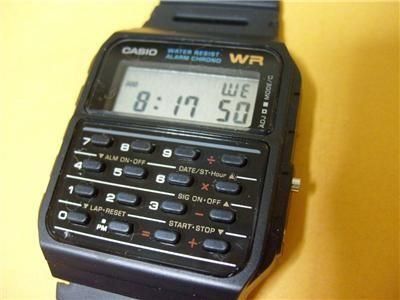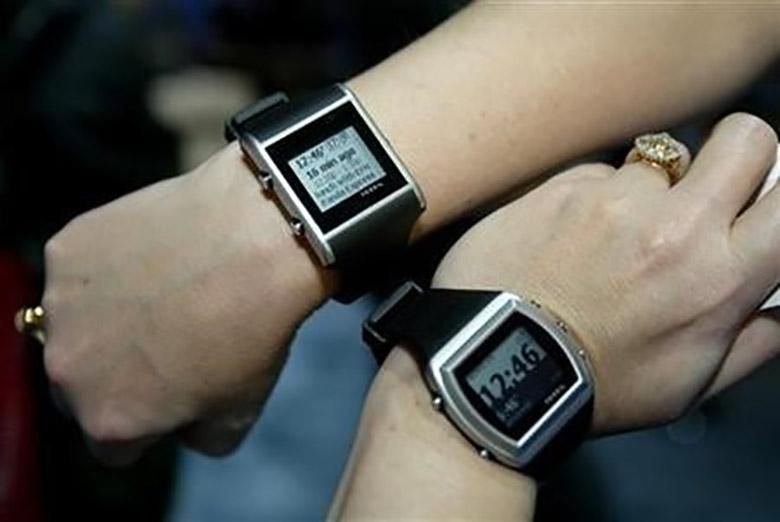I remember back in 2002 when I first started using smartphones, everyone else was using iPods and flip phones. The iPods were for music and the little flip phones were for phone calls. I thought that was all pretty ridiculous since my phone could do all of that, plus play videos, browse real web pages, send/receive emails, sync my calendar & contacts, play games, etc. all on a large color screen at a time when iPods and cell phones had tiny greyscale screens. All of those devices had clocks on them so since everyone was carrying a phone and an iPod around at all times, the need for wristwatches completely disappeared. You may remember that Microsoft released a smart watch system at the time. A number of manufacturers made smart watches using Microsoft’s SPOT system which could download updates and notifications over the air (without the need for a local connection to a phone). Joe Levi gives us a good history of other smartwatches over the years, too.
Fast forward to today and we’re seeing many new smart watches mainly designed to work with Android smartphones, with a few that also work with iOS smartphones. In other words, they’re smartphone accessories… Just like Bluetooth headsets! Everybody wears those now, too! Or do they?
It looks like Google is repeating history with their new Android “Wear” operating system for smartphones. Will it fail just like Microsoft’s SPOT did years ago? We don’t know yet, but Taylor thinks smartwatches will not be a fad.
Does it make anything that much easier?
Back in 2002, merging your phone, PDA, and MP3 player made a lot of sense. Carrying two or three portable electronics devices was a pain. You had to monitor the battery levels of everything, you had to have enough pockets for everything, and on longer trips you had to pack multiple bulky chargers. Merging all of those portable electronic functions into one device that you could keep in your pocket was a huge advantage, and today everybody owns a smartphone. Rarely do you see people carrying a separate PDA, MP3 player, and cell phone.
Now with a smart watch, things are kind of going in a different direction. You’ll again need multiple chargers and you’ll have to monitor multiple batteries. It definitely doesn’t replace your smartphone since most of these modern smart watches need a connection to your smartphone in order to function properly. So those are a few negative points on the “making things easier” scale.
However, having a smart watch on your wrist means you only have to tilt your arm in order to see things like notifications or weather updates or the time. Compare this with a smartphone in which case you have to reach into your pocket, take the phone out of your pocket, and then look at the screen. Some smartphones you have to actually press the power button and then slide your finger somewhere in order to unlock it before you can look at the screen and find what you’re looking for. Many these days have a special mode that displays pertinent information on the screen as soon as you take it out of your pocket. Those features greatly reduce the need for an extra device to display notifications, at least in my opinion.
Typing
It’s not very easy to reply to text messages with a smart watch. In the case of the new Google Wear smart watches you have to use voice recognition and we all know how well that works in very loud public areas (not very well). So even if you see a notification on your wrist, you’ll most likely still need to reach into your pocket, unlock your smartphone, and use that to respond.

Now, when you’re in a quiet area, voice recognition on a smart watch is going to work much better, but guess what… voice recognition on your smartphone also works great in those circumstances. When I receive a text message, my phone can be on the other side of the room and it will say, “New message from so-and-so. You can say read it or ignore.” Without anything on my wrist whatsoever, I say “read it” and the phone responds by reading aloud the message I just received.
I’ve actually had pretty good results using voice recognition while my phone is in my pocket too. I can be on my bicycle on a quiet road and with my phone’s volume turned up, I can hear and respond to the speech UI surprisingly well. The distance from my mouth to my pocket is just about the same as the distance from my mouth to my wrist, so again having a speech UI on my wrist doesn’t seem like it would make much difference.
One thing that would and does make a smartphone’s speech interface much easier to use in louder areas is a Bluetooth headset. With one of those (built into my motorcycle helmet for example), I can engage all sorts of smartphone functions and interactions without even having to look at my wrist! Now that’s something that makes things easier!
One handed usability and safety
Another problem I just hinted to was the one-handed usability of a smart watch. It’s attached to your wrist, just behind your hand, so that’s going to mean whatever hand it’s attached to is basically not going to be usable for interacting with the device. You’ll have to use your second hand, along with your eyes, and then that means your full attention is consumed. This is not an efficient scenario at all especially if you’re outside in the world doing something. Although a twist of the wrist and glance at the screen is certainly quicker than pulling a phone out of your pocket, but if you’re holding a cup of coffee while you turn your wrist to see a notification, you’ll probably risk pouring that hot coffee all over yourself. (That was a joke, people.)
A Bluetooth headset actually makes for a much more efficient interface. You can activate your phone’s speech interface with one hand and one button press, then for the rest of the interaction, your hands are completely free to do more important things like operate a vehicle.
Convenience
How often do you have to recharge a smart watch? How often do I have to take it off my wrist? How heavy is it? Will I need to buy a different one when I buy a different phone? Is it worth the $200+ price tag (you can get 4 Nokia Lumia 520s for that price.)
While I haven’t really gotten to use any of the new smart watches yet, and none of the current models would work with my preferred Windows Phones anyway, my personal feelings are leaning towards them being more trouble than they’re worth. Most of the convenience advantages can be had by using the speech UI in your smartphone with a $13 Bluetooth headset in your ear, and the things that can’t be done with a speech UI via Bluetooth seem to be just as do-able (if not more-so) from the smartphone that I have to carry anyway.
Can you think of any scenario where you would not be able to use your smart phone but would be able to use a smart watch? And are those scenarios worth all of the other negatives that you would have to put up with in terms of owning a smart watch?
Picture via Clubic

